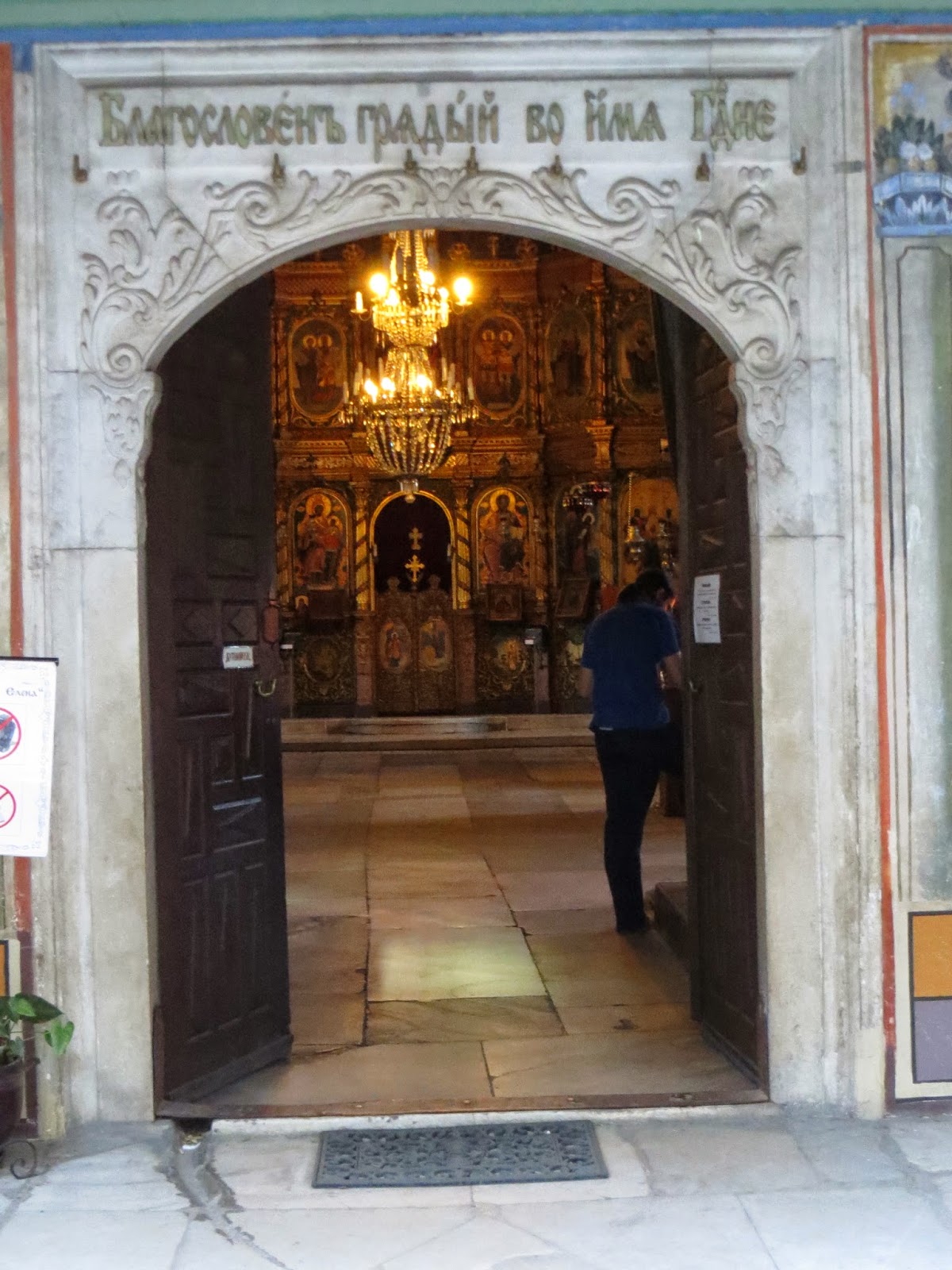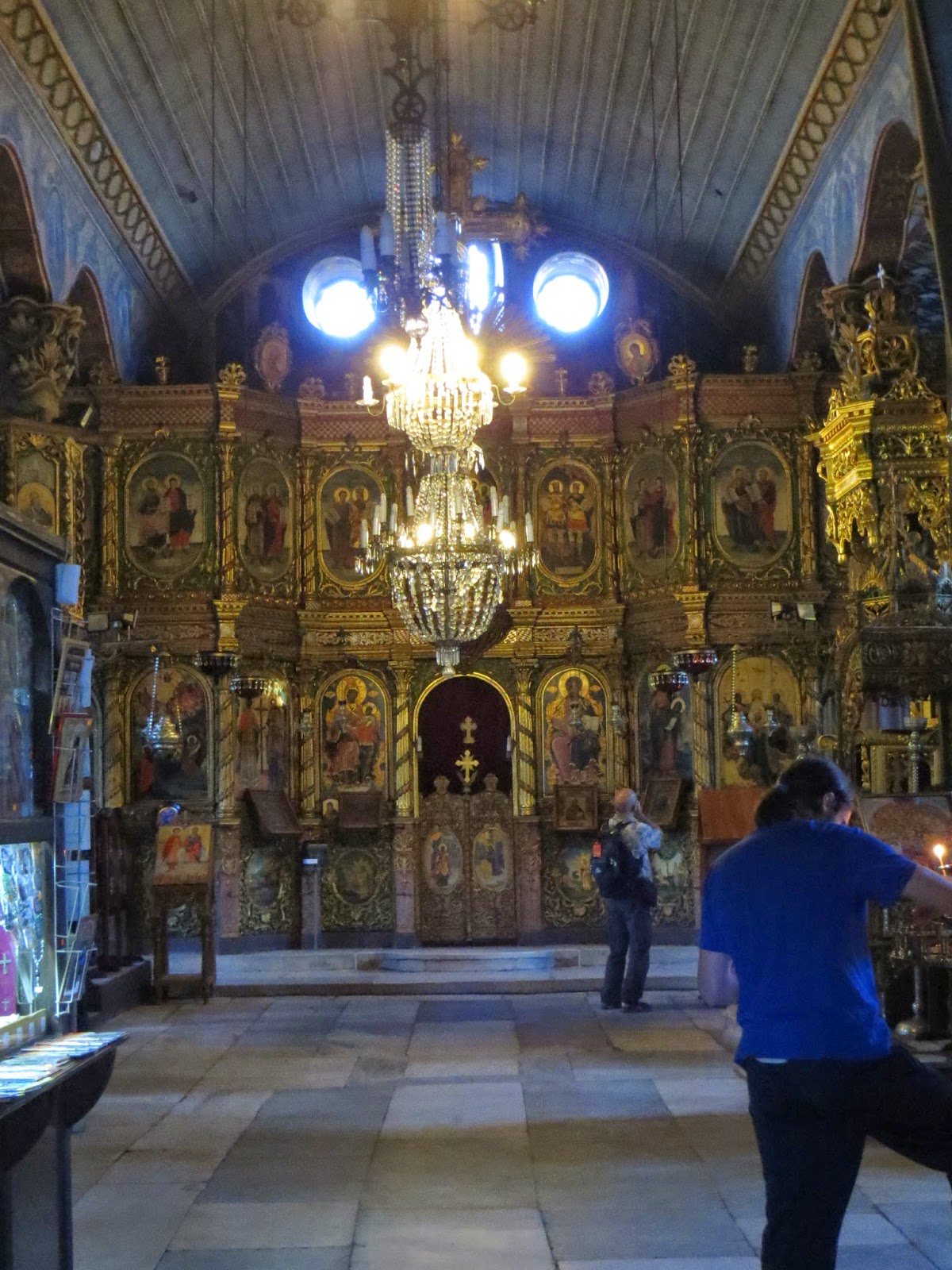I'm sure many of you are questioing why we ever decided to add Plovdiv to our list of cities to visit this trip. I only heard about it from someone living in Hawaii I corresponded with on the Bulgarian Trip Advisor forum who strongly encouraged us to come. It's known as Europe’s oldest,
continuously inhabited city and the 6th in the world and has the longest pedestrian street in Europe; more trivia for you, Lina!
In 2012 Plovdiv was listed in 3rd place, following Rome and Athens, in the ‘Top 10 Most Beautiful Ancient Cities in the
World.’ The city is hoping to be the winner of the 2019 European Cultural
Capital, the designation achieved by 2 other cities we’ve visited this trip: Pecs in Hungary and Sighisoara in Romania. Like Rome, Plovdiv
boasts of having seven hills although only 6 remain today thanks to the
Communists having flattened one!
Unlike many other cities with ‘old towns’ Plovdiv’s has eminent artists still living and working in the tranquil confines of its Old Town. The neighborhood boasts Thracian, Roman, Byzantine and Bulgarian antiquities, the most impressive being the Roman Amphitheater which is the best preserved one in the Balkans and still used for performances.With its art galleries, winding cobblestone streets, it’s a charming city with a decided international flair, thus very unlike Sofia.
 |
A sculpture of one of Bulgaria's famous artists outside the Academy of Fine Arts, Drama and Music in Old Town.
Look at the photos below and you can see how thrilled we were to be staying at the charming Guest House Old Plovdiv. |
 |
| All the guests who had reservations were greeted by individual welcome signs, in their own language too, upon arrival. What a special touch. |
 |
What a large room
especially after the Cozyness Hostel in Bucharest! I asked Hristo, the owner, if we had it all to
ourselves or whether it was a dorm; other guests checking in late one night
asked me the same thing! Turns out all 9 rooms in the home, built in 1868 by a
rich tobacco merchant, have either 3 or 4 single beds.
|
 |
| Lovely sprigs of lavender on each of our pillows greeted us on our arrival. |
 |
| I whiled away many an hour in the lounge sitting on the chair to the right updating the blog. Our room was just to the top right in the above photo where you can see a sliver of light. |
 |
All the tables in
the basement breakfast area had Singer sewing machine bases! There were also
old Singer machines, for decorative purposes only, in the lounge - not
sure if Hristo had seamstresses in his background or not.
|
After tearing ourselves away from the delicious iced tea given us in the back garden while chatting with Hristo, we walked through the cobbled streets of Old Town to Dzhumaya Mosque, the 2nd largest one in Plovdiv,and built between the 14th and 16th centuries. It was hard to find it as there was a large outdoor café obstructing it on the side we entered from.
 |
We first saw the
mosque from the left hand side by the cafe tables and the only entrance was going behind the tables up a small flight of stairs. The photo below
shows a full view of the mosque from the square.
|
(How absolutely
fitting that as I wait forever for these 2 mosques pictures to load, I’m listening
to the morning ‘Call to Prayers’ from one of the many nearby mosques here in Edirne, Turkey on 10/3. Not sure Steven will be able to
sleep through it even with his earplugs because it’s very loud over a huge
PA system. Sure don’t need an alarm clock here if you want to be up by 6!)
 |
| How lovely being able to sink our toes in the thickly piled carpet of the empty mosque. |
 |
The women's area
during prayer services, located at the rear of the mosque. Don't know if
children aren't welcome during prayer time or if they also stay here depending
on their age. There are no seats anywhere in a mosque.
|
Located on the same square was the Roman Stadium that had once been located in a hollow between 2 of the city’s 5 hills and had a capacity of 30,000 spectators. Now though it’s under the main pedestrian street and only has 14 rows of seats.
 |
| While standing here taking this photo, I happened to glance to my left and saw the mammoth billboard below advertising something about Canada! |


Walked 5 minutes over to Sahat
Tepe (tepe means hill in Bulgarian), to look more closely at its Clock
Tower; the original one dates back to 1623 but the present one was built in 1823. A sun
and water dial from the Roman Ages was discovered there.Neat to be
able to have our first look at the other hills and the city below from such a
beautiful vantage point.
Walked to the Municipal Area with its beautiful fountain, ingenious park seats, political campaign offices in tents and cafes everywhere you looked. We could have been in any western city in the world in that part of Plovdiv. In the center of the square was a very large and unattractive Post Office built during the Communist era.
 |
| They reminded me of the 'loonies' i.e. Canada's dollar coin. |
 |
Election tent with the candidates each having his own number, NOT a candidate's tent number.
Next we spent some time wandering through the large Tsar Simeon’s Gardens seeing many monuments of Bulgaria’s spiritual leaders and lots of modern sculptures. The park had the best playground I’ve ever seen, a hundred times nicer than any playground I’ve seen in Canada or the US. Come to think about it, all the large urban parks we’ve visited from Hungary east have had incredible playgrounds in their parks. How incredibly fortunate the children are to have these oases of fun so close by.
Behind the post office was the Ancient Forum and the Odeon, built at the end of the 1st C. following a Roman model. What a jarring contrast to what we’d seen just minutes earlier with all the beautiful buildings, modern cafes and fountains.
|
 |
| Photos above are of the Ancient Forum. Below are photos of the Odeon. |
Our next stop was Sveta (saint
in Bulgarian) Marina’s Church: About a dozen
people either stood or sat in the seats only lining the perimeter of the
church. Steven commented that the Orthodox priests who were singing or
chanting, sometimes individually and other times in unison the entire time we
were there, sounded very much like a (Jewish) cantor reciting prayers in a
synagogue. The church is the main temple of the Plovdiv diocese and its church administration, Plovdiv
Bishopric. It was restored as a bishop’s temple in 1853 over the ruins of a 16th
C. medieval church. Over one of the entrances, there’s a stunning multi storied
wooden tower built in 1870.
 |
| Seats like these were the only ones and rimmed the perimeter of the church. |

 |
| The church backed up to one of the city's many hills; I happened to look back while climbing the nearby steps for another view and noticed the priest. |
We were getting tired by that point so walked
back to our hotel through the twisty, very hilly Old Town streets. Our first stop was at the beautiful Assumption
Cathedral Church built in 1859.
 |
| Old Town's Lamartine House visited by French President in 1989. |
 |
Lina and Christine: bet you didn't expect to see a French sign in one of my posts!
Old Town is certainly an interesting place to walk as long as you don’t mind spending every moment looking down on the uneven boulders on all of the Old Town streets; anyone wearing heels or having weak ankles or knees would not be advised to tread anywhere close! We've walked on cobblestoned streets all over before but never experienced anything as difficult to trod on like the ones in Plovdiv's Old Town.
|
Almost next door to the Cathedral was the Sveti
Sveti Konstatin and Elena, an orthodox church constructed in 1832 in a
courtyard with a former school, a male convent (another new one for me) and
another bell tower. We could hear its bells ring from our hotel, just a stone’s throw away.
Many of you have commented on
how much we see in a day and I can appreciate your sentiments. I think though I’ve
not done an adequate job explaining how often many of the sights we’re seeing
are very close to each other so it doesn’t take us long at all to tour each of
the ones in the posts. Plovdiv is certainly a prime example of that as we ‘saw’ all
of the above sights in only 4 hours or so in an afternoon and that was after
taking the bus in from Sofia. I am confident that it wouldn’t have taken so long
if I hadn’t slowed us down on the cobblestone streets which I found quite
treacherous and a step away from having a sprained if not a broken ankle!








































































I often wonder what the streets in Old Town look like in the winter. Do they still have outdoor dining? Or does it become empty? Polish girl
ReplyDelete